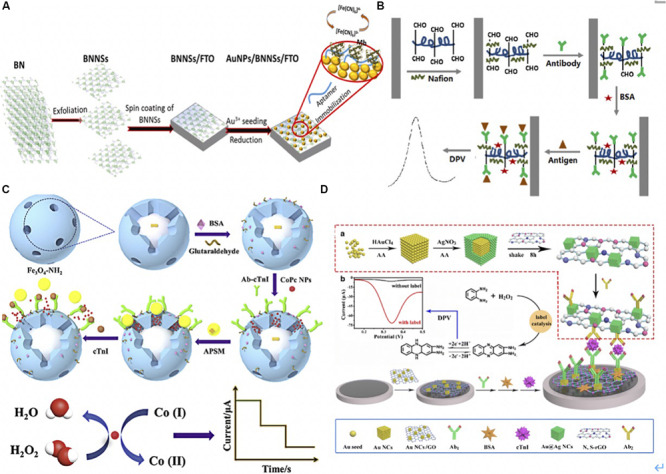FIGURE 4.

(A) Schematic illustration for aptasensor fabrication and MB detection process. BNNSs were obtained from filtered BN powder dissolved solution via hydrothermal method. BNNSs were spinning deposited onto FTO electrode. AuNPs were then functionalized onto BNNS/FTO electrode to form AuNPs/BNNSs/FTO electrode acted a transducer to fix a thiol-functionalized DNA aptamer (Apt) via the Au-S covalent interaction. The [Fe(CN)6]3-/4- was used as a redox probe to monitor the oxidation current variation after MB binding to the Apt (Adeel et al., 2019). Copyright (© 2020 from Elsevier B.V. (B). The illustration of electrochemical immunosensor. DIL was noncovalently non-covalently bonded with HCNTs to form the DIL-HCNTs composite, which provided sufficient binding sites for Ab1. After antigen was capture by Ab1, the sandwich immunocomplexes formed on the electrode hindered electron transfer thus decreased the peak current of DPV. The signals were corresponded to concentrations of cTnI (Shen et al., 2019). Copyright 2020 American Chemical Society. (C) The preparation procedure of the sandwich-type electrochemical immunosensor. Dispersed Fe3O4-NH2 and glutaraldehyde was stirred to form Fe3O4-Ab1, BSA was added to block remaining active sites on the surface of Fe3O4. CoPc NPs were first dispersed in the mesoporous of Fe3O4-Ab1, then APSM was used to cap on the mesoporous of Fe3O4-Ab1 by electrostatic interaction and formed APSM-capped CoPc NPs- Fe3O4-Ab1. Once the target cTnI was captured, CoPC NPs were released after APSM was separated. The CoPC NPs oxidized the cobalt element from Co (I) to Co (II) with H2O2. The reduction current was corresponded to concentrations of cTnI (Ma et al., 2019). Copyright 2020 from Elsevier B.V. (D) The schematic diagrams of preparing Au@AgNC/N, S-rGO-Ab2. Au solation was mixed with AA and AgNO3 in turn, then the Au@AgNC were collected using centrifugation. Later, Au@AgNC and S-rGO were reacted for 8 h for Au@AgNC and S-rGO composite. Ab2 solution was added into Au@AgNC/N and S-rGO, and oscillated to form Au@AgNC/N, S-rGO-Ab2. AuNC/GO immobilized Ab1 via amino-Au affinity. Once cTnI was captured, the catalyzed-oxidation of o-phenylenediamine (o-PD) with H2O2 was accelerated. The oxidation generated 2,3-diaminophenazine that gained in electrons and hydrogen and generated a larger current signal of DPV at 0.34 V (Lv et al., 2019). Copyright 2020 Springer Nature Switzerland AG.
